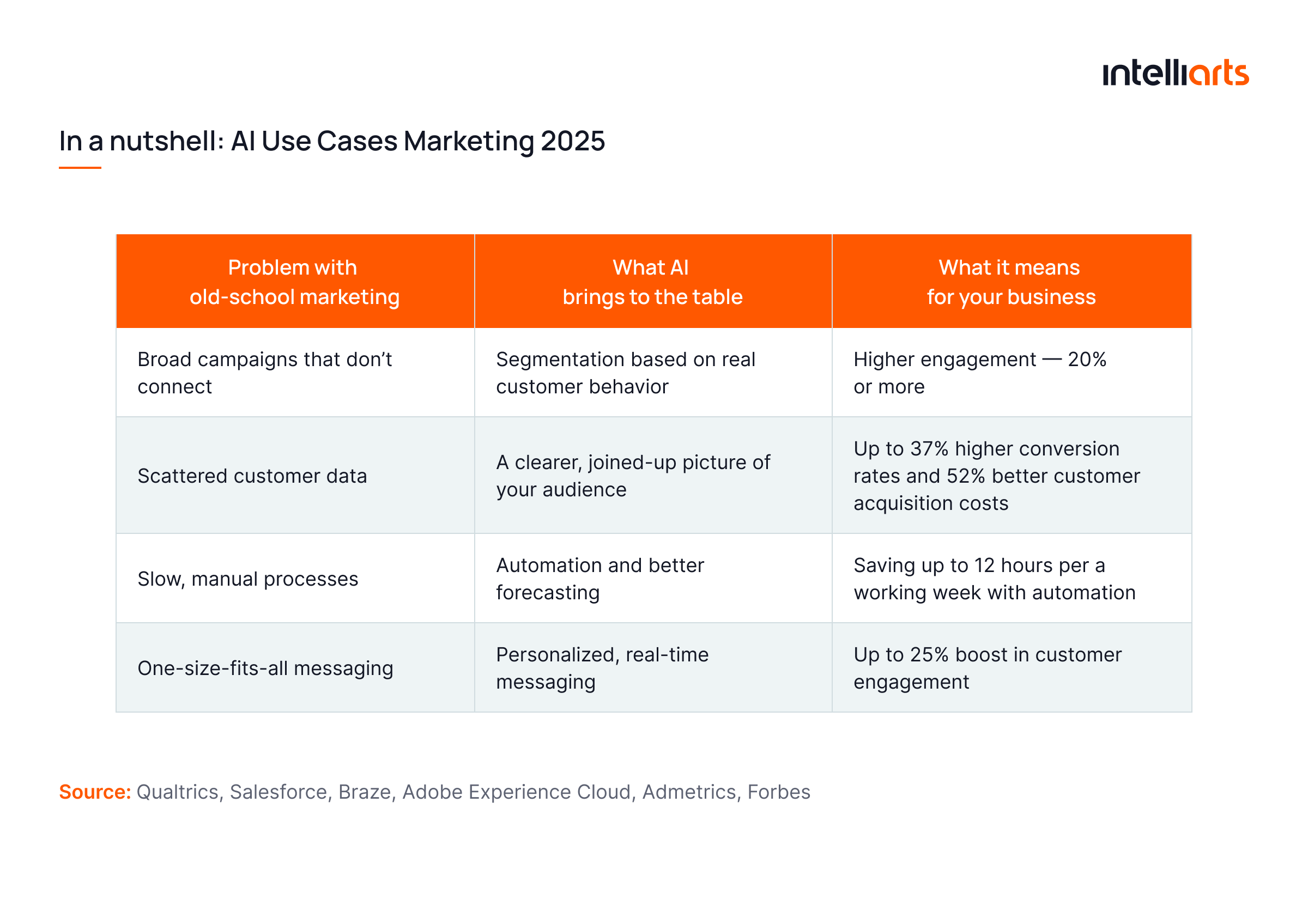Why isn’t marketing working like it used to? Most marketing teams have the data. The tools are smarter than ever. But conversions? Stalling. CAC? Creeping up.
It’s not just for the lack of effort – marketers work harder than ever. What’s missing is clarity. And that’s exactly where AI in marketing statistics is starting to shift the equation. In 2024, 3 out of 4 marketers used at least one or more AI tools, according to a Hubspot survey.
At Intelliarts, we have experienced and witnessed how the appropriate AI tools can enable teams to transition out of general campaigns and increasing expenses to specific, high-value, data-driven marketing. But AI isn’t magic after all. It’s methodical. And it works when you know where to apply it.
In this post, we’ll show what that looks like in practice — with stats, results, and the unexpected blockers most teams usually don’t talk about.
If you’re trying to figure out how to actually make AI part of your marketing strategy — this is your starting point.
How marketers are using AI in 2025
AI isn’t a shiny new tool anymore — it’s become part of the everyday toolkit for marketing teams. AI in marketing and market size of AI tools is expected to grow significantly in the next few years (make sure to check the statistics at the end of the article). According to a recent HubSpot report, nearly 3 out of 4 marketers used at least one AI tool in 2024 — more than double the number from the year before.
From what we’ve seen across agencies, in-house marketers, and startups, the majority aren’t using AI to write full blog posts or launch entire campaigns. Instead, they’re folding it into their automated workflows in small, practical ways that save time and unlock capacity.
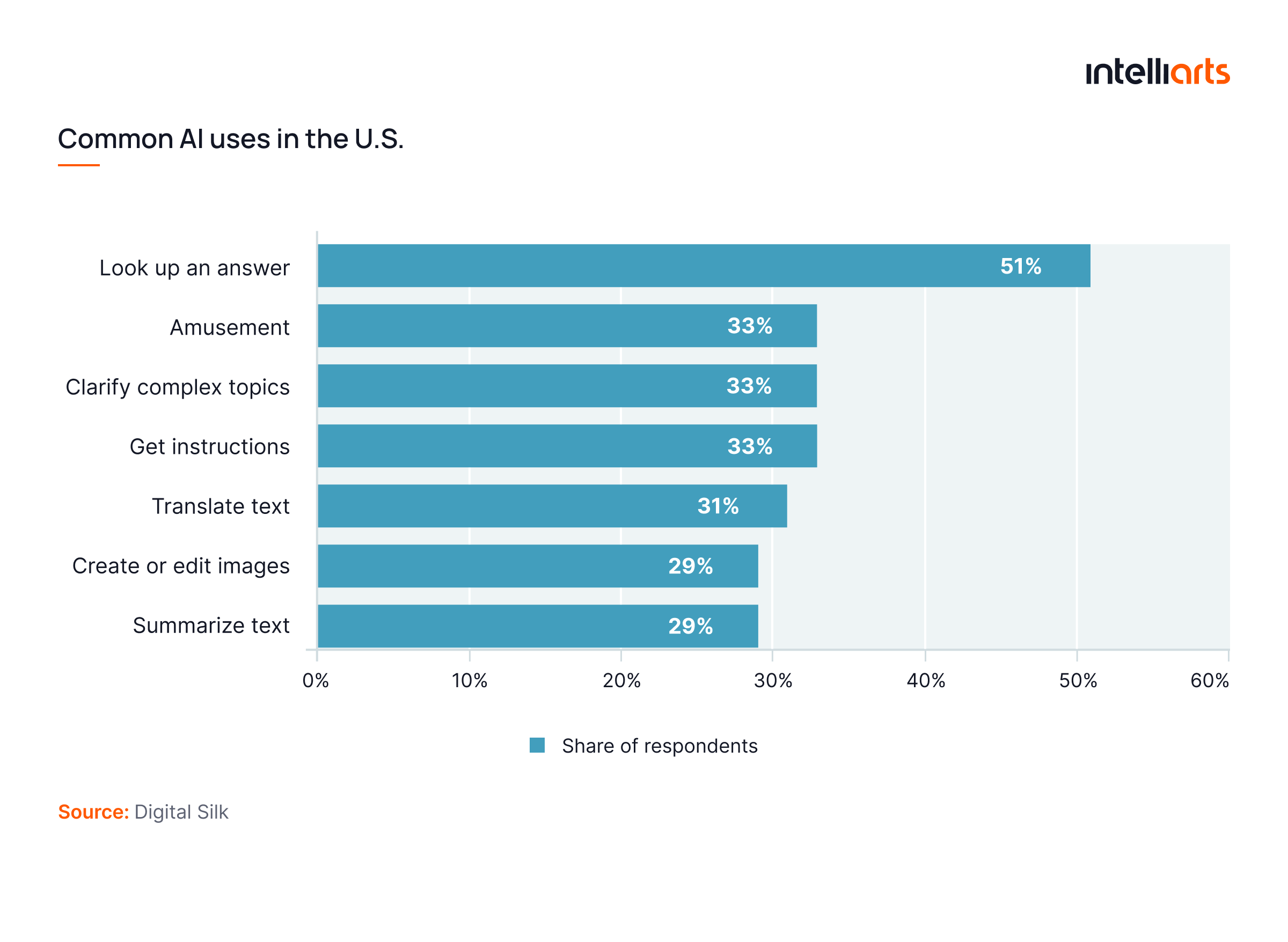
But here’s what’s most interesting: it’s not just about experimenting with new tech. In fact, most marketers are turning to AI to plug real gaps in their workflows. We’re talking about things like:
- Replying to customer queries faster without ballooning support costs
- Creating content that’s a better fit for specific audiences (without starting from scratch every time)
- Analyzing data on several campaigns in real time with the help of AI, which allows marketers to identify trends and make adjustments in a short period of time
- Segmenting customers based on behavior and preferences using AI-driven segmentation and AI marketing automation statistics capabilities that are way beyond the manual approach of segmentation
- Speeding up the boring stuff, such as editing drafts, summarizing reports, or generating content ideas
Bottom line? AI acts as a co-pilot, not the whole crew. It’s great at helping you move faster but as long as you’re behind the steering wheel.
Want to learn how to do data extraction automation with ChatGPT? Feel free to read our article.
AI in digital advertising and marketing
We usually read about the use of AI in marketing research, but its influence is much broader. AI is transforming the modern marketing strategy, whether it is smarter customer segmentation, content creation, or campaign optimization. So, what are the most important areas of AI marketing applications that bring tangible benefits? Let us take a closer look at them along with figures and success stories.
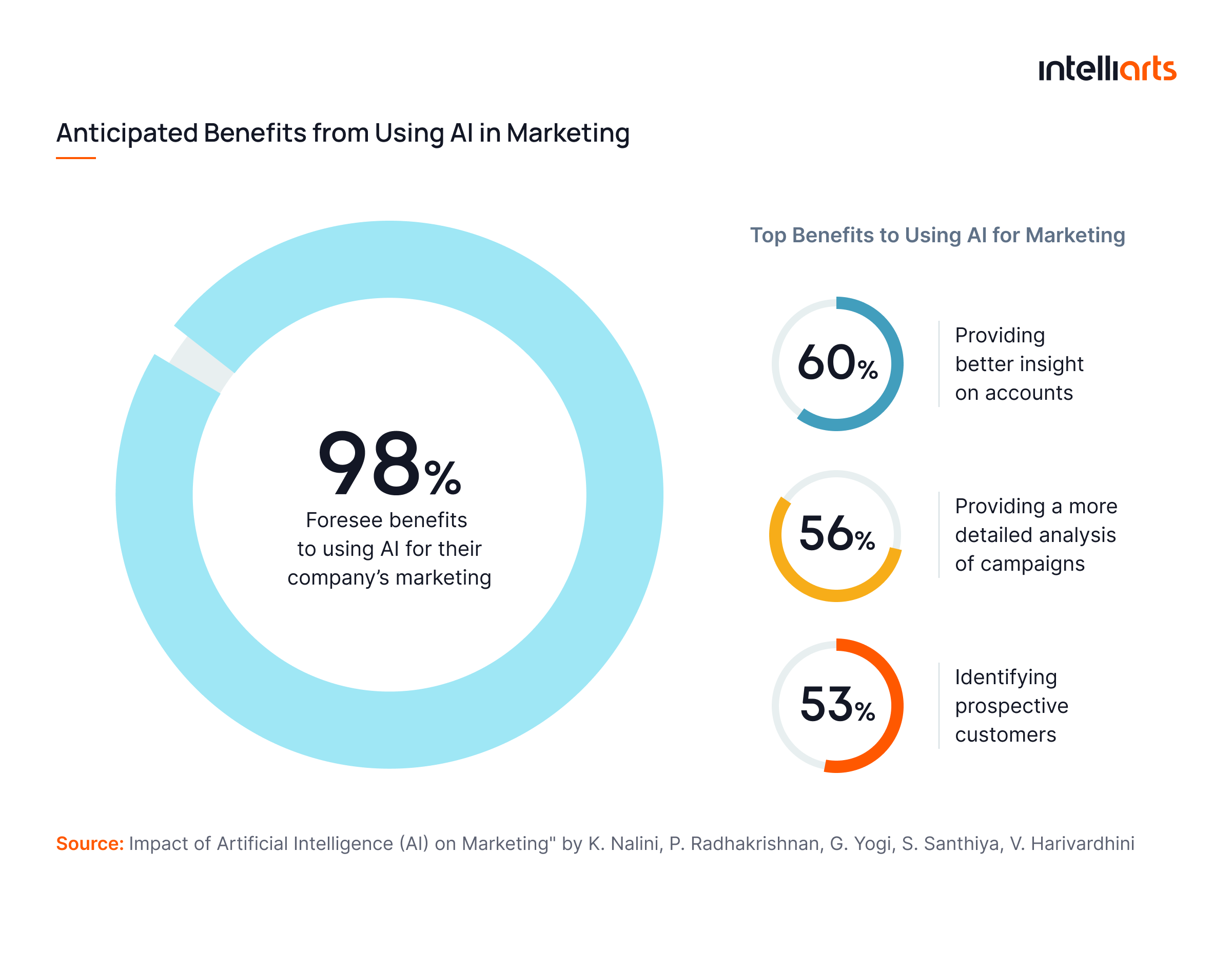
Getting segmentation right
Figuring out who should get what message has always been a headache. Traditional lists are broad, and blasting the same email to everyone rarely hits the mark. AI changes that by digging through all kinds of customer info, from what they’ve bought to how they interact with your emails, and sorting people into groups that make sense.
Stat: Latest AI marketing stats show 20%–30% higher engagement metrics from personalization efforts (Hubspot, 2025).
In other words: people pay more attention when it feels like the message was made for them.
According to a recent study featured in Forbes, some models do exceptionally well. And the outcome? Emails that actually feel like they’re made for the reader. It’s no surprise this kind of targeted messaging can boost open rates by about a third.
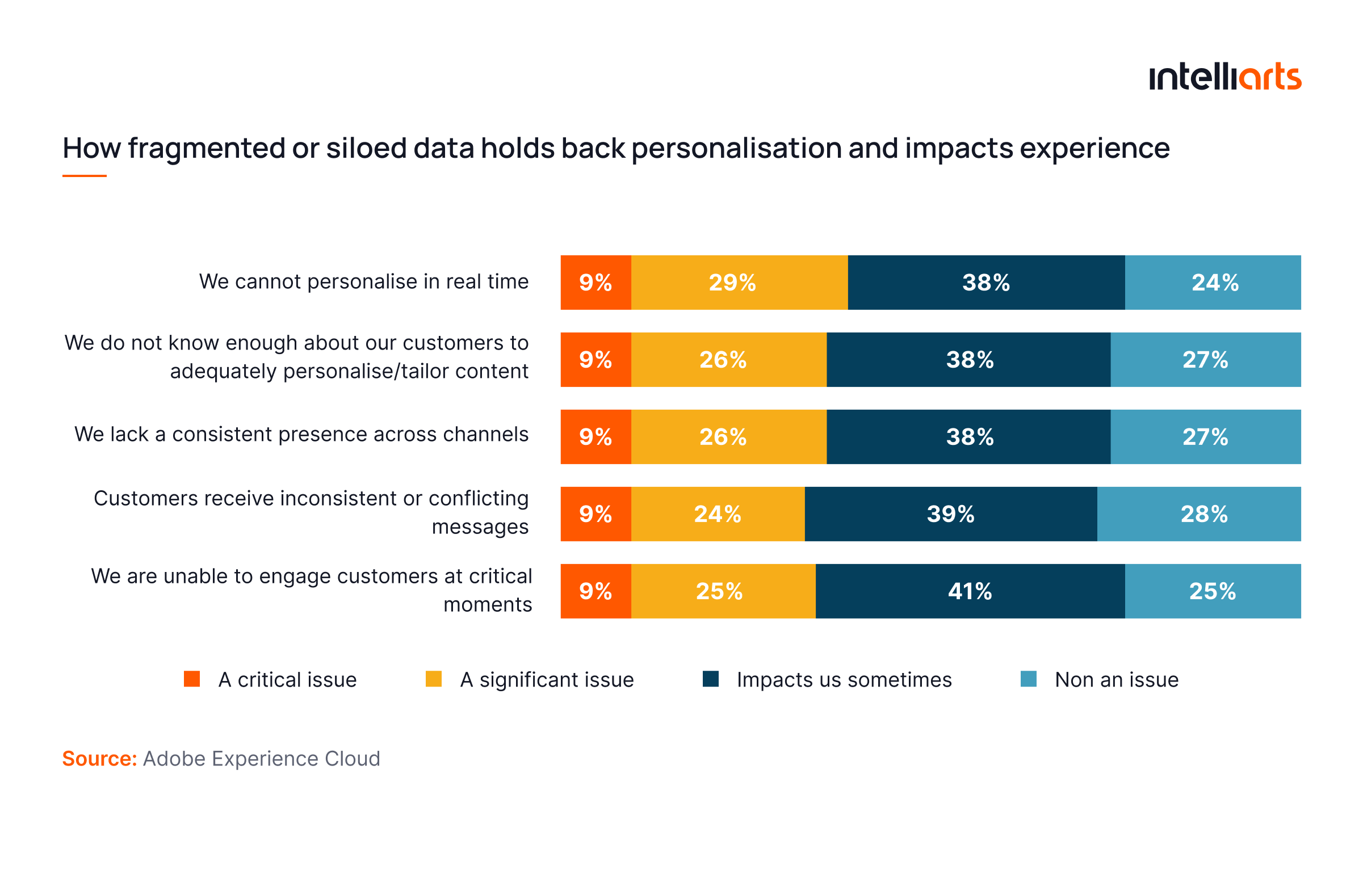
Content creation
A poor strategy may put a strain on marketing, but campaigns tend to stall even when they are well-planned. It’s because teams are unable to keep up with the demand for new, relevant assets. AI can assist teams to test more variations within a shorter period of time: headlines, visuals, calls-to-action, all of which are customized to different audience slices. To speed things up even further, many marketers combine AI tools with design resources like free templates, reducing production time without sacrificing brand consistency.
Marketers can concentrate on what works in messaging, and offload the mundane and routine work to automation, instead of rewriting the same copy ten different ways. Let’s check some artificial intelligence in marketing data below.
Stat: The content created with the help of AI, such as an AI Avatar Generator, can be generated five times faster than the one created manually. It doesn’t necessarily mean it’s better but this allows marketing teams to develop multiple versions of the content to target various audience groups and have a competitive advantage (Jasper, State of AI in Marketing 2025).
AI in marketing statistics show 70% of companies that use AI for their departments use AI for at least 1 function, while 62% of marketers who use AI also say it improves their job enjoyment.
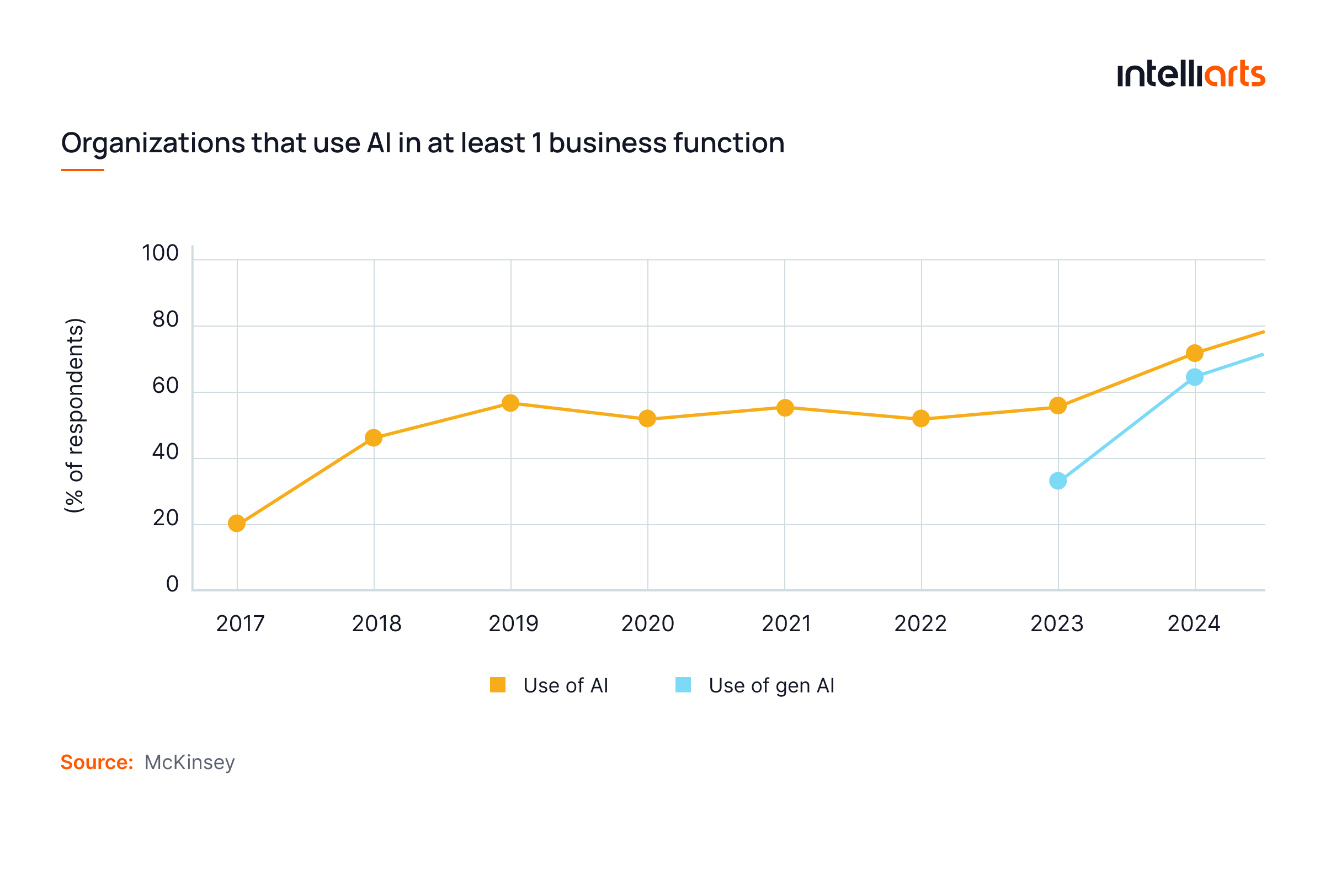
Personalization
AI marketing trends show that the majority of marketing teams are aware that personalization is important, but scaling it often implies a compromise between speed and precision. And most departments don’t want to compromise precision.
Marketers can create content variants that directly address various behaviors, interests, or prior actions with AI, but they don’t have to rewrite everything each time. That makes campaigns tailored, not “templated”.
Stat: It might sound simple, but these smarter subject lines can lift click rates by around 10%, which adds up fast.
Stretching your ad budget further
When you’re putting money into digital ads, you want every cent to count. AI-powered bidding systems keep adjusting on the fly, learning which spots and audiences give you the best return.
Stat: Predictive analytics can forecast customer behavior and trends, allowing businesses to anticipate needs and tailor their strategies and budgets accordingly. More advanced teams also measure incrementality to understand which AI-driven optimizations genuinely move the needle. This kind of real-time tweaking can cut your cost to acquire customers by nearly a third — down to 37%, according to marketing AI statistics from SuperAGI, making your ad spend much more efficient.
Ads that speak to people
AI doesn’t stop at segmenting and bidding — it also predicts which ads will resonate with different groups. That means your marketing dollars go toward campaigns with a better chance of connecting and converting.
Stat: 71% of marketers believe generative AI will allow them to focus more on strategic work, including personalized messaging (Salesforce).
Marketers see personalized ad relevance jump by at least 25%, driving stronger results without wasting budget (Microsoft).
AI in action: Driving ROI and marketing success
When every dollar spent on marketing is important, AI helps by making a real difference and showing clear results everywhere.
- Customer acquisition costs slashed nearly in half
It’s no longer necessary to guess which leads will convert. Lead generation with AI and lead scoring studies data in detail, identifying patterns and signs that show which prospects are most promising. Because of this, companies can reduce their customer acquisition costs by 30% and attract contacts who are truly interested and more likely to become customers.
- Conversions moving up
AI doesn’t only help find the right audience; it can also change messages and personalized offers depending on customer actions and preferences. When personalization is applied, users have a better time and they are more likely to become paying customers. The result? Conversion rates can jump by around 20%, helping businesses grow without having to pump more money into acquiring traffic.
- Getting more from every ad dollar
AI can help you make the most of your digital advertising budget, even if it’s not huge. AI helps marketers find out where their ads are most effective and then move their budgets to those channels and audiences. With this strategy, businesses can see a 5% to 10% rise on average in the return they get from their ad spending.
Make sure to check our article on AI poc development examples if you want to learn about how to validate ideas and minimize risks with adopting new AI marketing tools.
Intelliarts on AI’s real impact across marketing
When we talk about marketing, our clients see firsthand how AI moves beyond hype. It’s about unlocking growth through smarter decisions. No fluff, just results.
Nowsite (Network Marketing Platform)
Intelliarts improved the stability of Nowsite’s CRM through code refactoring, architecture redesign, and quality-control systems. As ChatGPT and LLMs grew up, we naturally enhanced AI throughout the platform together with the Nowsite’s team: personalized AI bots, expert-trained chatbots, social media, post generation tools, auto website and email campaign builders, as well as scalable prospect search.
Key results of CRM integration:
- 100,000 users in 140 countries
- 112% year-on-year user growth
- 130% revenue growth
- New strategic partnerships (Herbalife)
- 95% user satisfaction
- Support for more than 50 languages
Optimizely (CDP & Marketing Platform)
The real-time Customer Data Platform for Optimizely was built from the ground up and combines more than 60 integrations into single user profiles. Now, it has instant AI-based segmentation, predictive behavior insights, and multi-channel activation.
The platform supports millions of messages per month with real-time orchestration, which allows quicker campaign execution, consolidated data, more personalized messages, and more revenue-generating marketing.
What was the metric for success:
- Real-time execution of millions of messages
- Faster launches
- Improved campaign performance
What’s holding businesses back?
Many businesses want to tap into AI’s full marketing potential but keep running into familiar roadblocks. Here are the biggest ones — and how to overcome them.
Budget constraints
According to IMH, 34% of marketers say limited budgets stop them from experimenting with AI. In fact, AI’s benefits don’t always show up overnight. For companies watching every dollar, investing without quick returns feels risky. Start small, run tests, and grow gradually — no need for all-in bets from day one.
AI tool adoption rate
Introducing AI tools into the current marketing systems is hardly a smooth process. Integration requires time, technical expertise and, in some cases, workflow changes. If you have difficulties, it is possible to hire AI experts or consultants to make the process easier and prevent delays and frustration.
- Nearly a third of marketers cite the slow adoption rate of the current tools as the main reason why they can’t use AI at its full potential, according to a 2024 Statista survey.
- In another survey conducted by ChainStoreAge, nearly a half of marketing departments simply don’t have the technical expertise to utilize AI just yet.
At present, many marketers are underutilizing AI, but the impact of AI in marketing is already transforming the business landscape, helping leaders make data-informed decisions with greater efficiency and accuracy. From predictive insights to immersive experiences, AI is redefining how marketers handle repetitive tasks, make decisions, and connect with customers.
– Christina Inge, author of “Marketing Analytics: A Comprehensive Guide and Marketing Metrics”
Concerns about data privacy
Privacy and fairness of data are crucial, particularly in regulated sectors. Nowadays, AI systems are being fitted with in-built safeguards, which enable businesses to maintain trust as they utilize customer data in a responsible manner. This is what the statistics say:
- 52% of marketers list data privacy as the top challenge for AI adoption (ChainStoreAge).
- According to Ortto, new legal frameworks, such as the EU AI Act and US CCPA, are prompting more companies to deploy privacy-preserving AI features (e.g., anonymization, secure storage).
Job loss concerns
One of the biggest fears is that AI will replace marketers overnight. The reality is that the goal of AI is to augment human abilities, allow marketers to do their work better, more efficiently and more creatively. It is not substitution but cooperation.
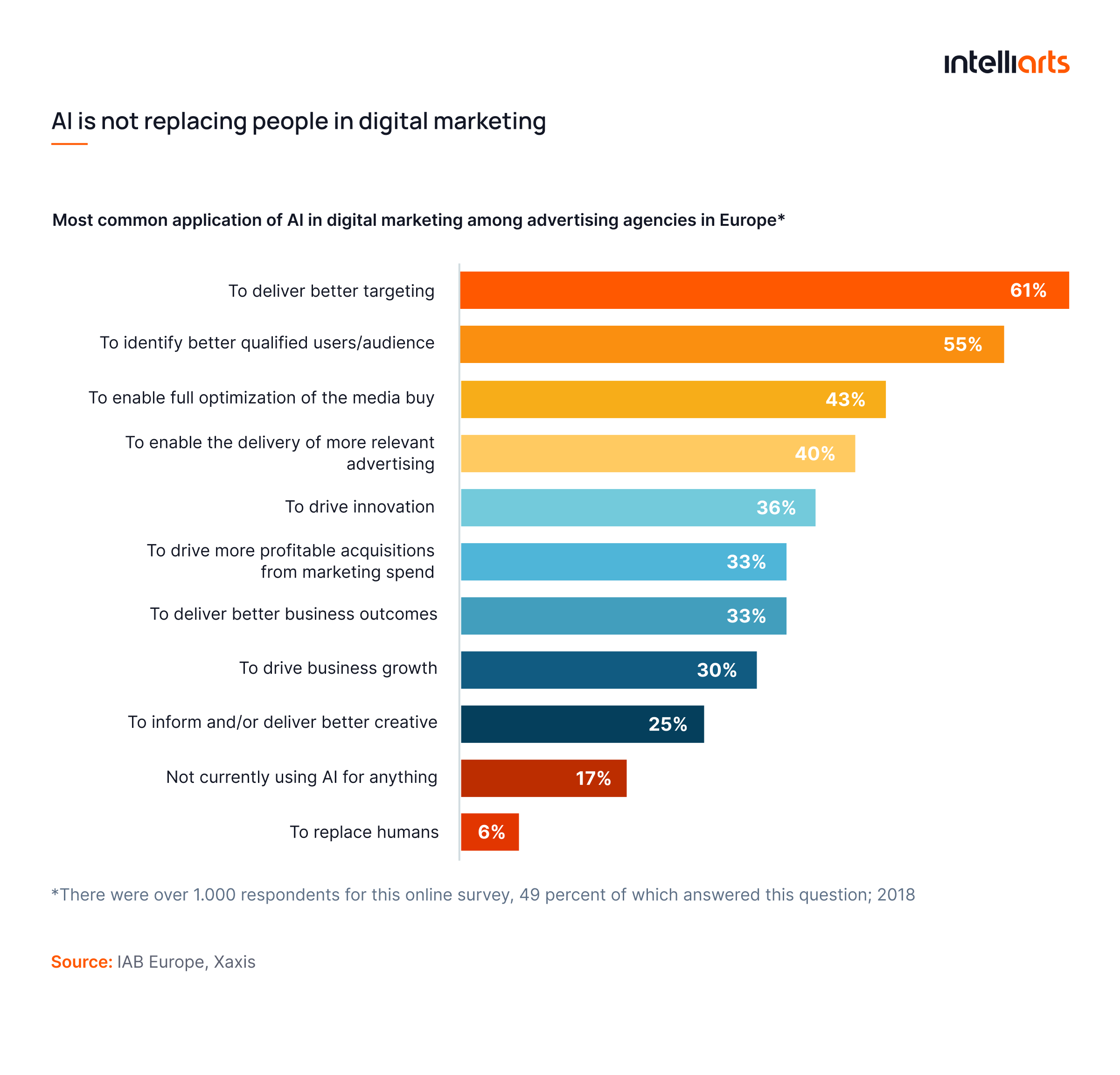
Predictions for 2025–2030
Looking ahead, AI in marketing is set to become the backbone of most strategies, forecasted to power up to 95% of digital marketing strategies by 2030 according to Gartner research. Adoption jumped sharply from 29% in 2021 to 88% in 2025, with expectations that AI will reach over 95% adoption by 2030 (IBM).
This shift is driven by the ability of AI platforms to analyze vast amounts of marketing data in real time, enabling smarter decisions, precise segmentation, and superior campaign optimization. Here are a few more important observations:
- AI turns vast, messy marketing data into clear insights that fuel targeted segmentation and smarter campaign optimization — no guesswork needed.
- In paid media, expect AI-driven real-time changes to become the rule. With machine learning, campaigns adjust instantly to what consumers do and how they interact — lifting conversion rates up to 20% (Statista) and getting more out of the marketing spend.
- This means budgets are no longer static; they flex and shift alongside live data. Under the increasing pressure of CFOs (63% of marketing leaders report increased scrutiny according to Single Grain), teams are abandoning fixed plans in favor of dynamic frameworks. These are test-and-learn models, quarterly reallocations, and setting aside up to 15 percent of budgets to in-flight optimization. This is not a trend, it is a matter of survival in the results-oriented environment.
- On the privacy front, ethical AI is setting new standards for personalization. Consumers want clarity and control over how their personal data is being used (85% of consumers, according to consumer behavior PwC data), and regulators are demanding it too. AI solutions that put privacy first build trust, a crucial factor in boosting customer retention, improving customer experience, brand awareness, and brand loyalty, according to Amazon.
- Looking at AI marketing statistics and current MarTech trends, marketers who marry innovation with respect for privacy will lead the pack in growth and efficiency. For example, 67% of americans are concerned with how companies use their data and this number will continue to grow. Adapting your marketing AI efforts accordingly is paramount for long-term success.
All in all, the global generative AI investment is expected to increase by 24.4% each year as businesses invest in AI-based creative, personalization, and optimization solutions (Semrush, Statista). While AI in marketing improves, market share is expected to grow too, from $28,67 billion in early 2025 to almost $100 billion by 2031.
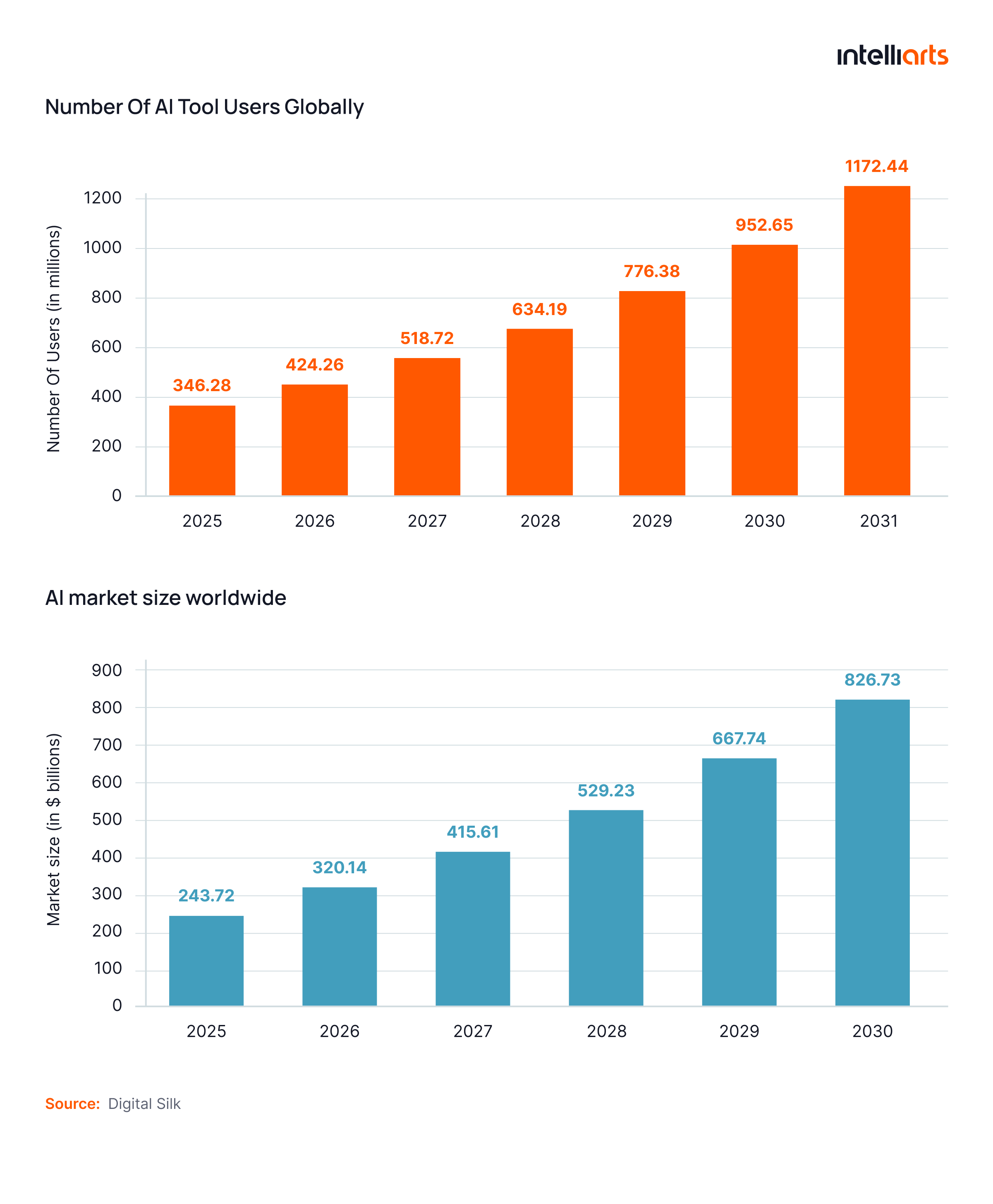
Summing up
AI has now officially passed the hype line in marketing. No more fancy demos, it is all about results: reduced lead costs, increased engagement, and more intelligent use of current budgets. Based on what we have observed, the greatest victories are achieved by teams that do not use AI to replace people, but to refine decision-making where it counts.
At Intelliarts, we have assisted businesses in transforming their slow tools and bulky processes to lean and AI-enabled systems. In one case, a client reduced lead costs by 30%. Others experienced 100% increase in users following the implementation of AI personalization into their platform.
But all is not rosy. Budget, integration friction, and data privacy remain the impediments to teams. Firms that pilot the tools, gauge their effect early, and develop around the workflow of their teams, not the manner in which vendors sell it.
FAQ
How effective is AI in marketing?
AI is everywhere in marketing these days. A recent report shows that 94% of businesses rely on it for planning or running campaigns because it works and improves results.
Which marketing tasks are best suited for AI automation?
AI can handle daily marketing chores like email campaigns and social media scheduling. Likewise, it can be a good tool for sorting leads. That way your marketing team can focus on being creative and strategic.
How do you balance the need for personalized recommendations with customer privacy concerns?
You achieve that balance through transparency and selectivity of your tools. Be responsible in personalization, explain to users what you are collecting and why, allow them to opt into what is important, and employ secure-by-design technology with privacy as a priority. In this manner, you are not only providing smart content but you are also establishing long-term credibility with your customers.





